USFL TEAM INFO
Here you will find information on all present USFL franchises, beginning with the 12 founding teams and progressing through the expansion, relocation, merger, and contraction of teams over time. Information here will be adjusted each offseason. Teams will always be listed as their current incarnation, so if you do not see the team you expected to find, look through other team histories to see if perhaps they now play in a different location or with a different identity.
Click on the blue helmet icon on each team listing to see an image of the current team uniform, the grey football icon will show past uniform designs,
THE FOUNDING FRANCHISES
Arizona Wranglers
Founded: 1983
Owner: Dr. Ted Dietrich
Championships: None
Stadium: Univ. of Phoenix Stadium (63,400)
Colors: Copper, Scarlet Red, Flag Blue, Athletic Gold
Hall of Famers: WR Jackie Flowers, WR Trumaine Johnson, LB Sam Norris, LB Kevin Greene, DE Charles Haley, LB Broderick Thomas
The Wranglers are the first professional football team for the city of Phoenix. Founded in 1986 by owner Dr. Jim Joseph, the franchise saw major upheaval in the offseason between the 1983 and 1984 seasons when an agreement between Dr. Joseph and Dr. Dietrich led to the wholesale swap of this franchise with the Chicago Blitz. Ownership shifted between the two teams as did the majority of both rosters. The Wranglers have had an up and down history, making the playoffs 8 times in their first 15 seasons. They have appeared in 1 1 Summer Bowls, losing to Washington in 1990's Championship and again to New Jersey in 2004. The team's logo depicts a fiery branding iron in blue, red and gold, while the team's helmet is a burnt copper color.
Baltimore Blitz
Founded: 1983 as Chicago Blitz
Owner: Louis Thalheimer
Championships: None
Stadium: M&T Bank Stadium (70,745)
Colors: Deep Royal Blue, Silver
Hall of Famers: DE Junior Ah-You, WR Jackie Flowers, WR Trumaine Johnson, LB Sam Norris,
DT Michael Dean Perry, DT William Perry, SS Bennie Blades, DT John Randle,

1986 1989 1998 2003 2011
The Blitz were founded by Dr. Ted Dietrich as the Chicago Blitz. After one season the Blitz swapped ownership and rosters with the Arizona Wranglers. Dr. Jim Joseph took over the Blitz, but after two mediocre seasons in Chicago with low attendance and little on-field success, Dr. Joseph sold the franchise to a Baltimore group who, with league permission, planned to relocate the franchise to Baltimore for the 1986 season. The decision to relocate may have been premature, as the Blitz exceeded all expectations in 1985, won their division and marched to the USFL Championship, where they were defeated by the Philadelphia Stars. Despite their success in 1985, the deal went through and the team relocated. Since moving to Baltimore, the Blitz have seen much better attendance and have been a stronger franchise both on and off the field. The team has traditionally worn blue, red, and silver, but for 2011 removed all red from their design and now sport blue and silver uniforms.

1983 1989 2001 2011
Birmingham Stallions
Founded: 1983
Owner: Marvin Warner
Championships: 1993
Stadium: Legion Field (83,091)
Colors: Crimson Red, Metallic Gold
Hall of Famers: HB Joe Cribbs, SS William Cesare, FS Frederick Wilder, TE Shannon Sharpe, WR Ernest Givens, OT Emory Yates, DE Chris Doleman, OT Richmond Webb, WR Lawrence Dawsey
The Stallions are in many ways an example of what the USFL has meant for football fans. Based in the SEC-crazed Deep South, the Stallions were received with open arms by fans in Birmingham. The team often finds itself near the top of attendance rankings and has built a dedicated fan base who appreciate that they can root for the Crimson Tide or Auburn Tigers all Fall and then root for the Stallions each spring. The Stallions have been a solid team for most of their existence, winning the Southern Division 5 times, appearing in 2 Summer Bowls and taking home the 1993 Title with Brett Favre at the helm of an explosive offense. The team's logo is a a wild stallion rearing up, shown from the chest up. The uniforms are crimson and metallic gold.

Denver Gold
Founded: 1983
Owner: Dick & Charles Monfort
Championships: 2000
Stadium: Invesco Field at Mile High (76,125)
Colors: Black, Athletic Gold
Hall of Famers: TE Keith Jackson, LB Kurt Gouveia, DE Leslie O'Neill, DT Michael Dean Perry, CB Bruce Pickens, LB Marvcus Patton,
1983 1990 1997 2009
The Gold have been a team defined by a sturdy defense and a somewhat stunted offense since their founding in 1986. Their original team owner Ron Blanding took a very fiscally conservative approach to the new league, eschewing the signing of expensive NFL free agents or top round rookies in favor of building a roster with NFL castoffs and mid-round rookies. In one way this plan paid off, with the Gold being the only team to turn a profit in the rough early years of the league. This strategy was also effective on the field, as Denver played its way into the first USFL Championship, where they fell to the Tampa Bay Bandits. In 1984, after 2 seasons, Mr. Blanding was feeling pressure to conform to higher salary expectations and a need to compete with other, less frugal, owners. He opted to sell the team to the Monfort brothers. Denver has still not been the sight for big name players, though their roster is certainly more dynamic than in the past. The Gold have developed a reputation as a tough home team that has trouble winning on the road. They have appeared in 5 Summer Bowls, including a string of 3 straight from 1999-2001, winning their only title in 2000.. Their logo features a gold D combined with a miner's pickaxe. Their original logo, a gold starburst, is still in use widely as well. Their uniforms feature black helmets, black jerseys and either gold, black, or white pants.

1984 1991 2001 2010

Los Angeles Express-Relocated 1992
Founded: 1983 (Sold & Relocated in 1992)
Owner: Alan Harmon, Bill Woodruff
Championships: None
Stadium: Angel Stadium (69,008)
Colors: Navy Blue, Silver, Burgundy
Hall of Famers: See Nashville
1983
The initial iteratoin of the Express found it hard to crack the tough LA Market, often playing to small crowds in both the LA Coliseum and later in Angel Stadium, leading them to relocate to St. Louis after 9 seasons in the City of Angels. The Express began their USFL journey playing in the cavernous LA Coliseum, and were simply unable to attract a crowd. After a season in which they had the lowest attendance in the league, they relocated to Angel Stadium in Anaheim, where they continued to struggle with attendance. The arrival of QB Steve Young helped to raise interest in the club, as did back to back division titles in 1984 and 1985. Playoff success has still eluded them though, as they failed to reach a USFL Championship Game. After several rough years to transition into the 1990's the club was sold and relocated. The original logo of the LA Express was a monogram "LA" with motion lines and a rightward tilt to denote speed. They wear silver helmets and pants with a navy jersey. Both their helmet and jersey stripes include burgundy red, but only in thin piping which is hardly noticeable at any distance.

Michigan Panthers
Founded: 1983
Owner: Al Taubman
Championships: 1984, 1986, 2008
Stadium: Ford Field (65,000)
Colors: Burgundy Red, Sky Blue, Champagne
Hall of Famers: WR Anthony Carter, LB John Corker, DT Jumpy Geathers, DE Ronnie Paggett, HC Jim Stanley, HB John Williams, QB Bobby Hebert, QB Doug Flutie,
1983 1993 2005
The Panthers were not expected to be a dominant team in the USFL, but they have proven to be one of the flagship franchises in the league. In their first 4 seasons the Panthers won their division all four years, were at or near the top of attendance, and were league champions twice, in 1984 and 2 years later in 1986. Many consider this team a true dynasty as it is argued that only key injuries kept them from appearing in the two other championships. The club has remained competitive though without new titles throughout the 1990's and have built a repuation of seeking veteran QB leadership after the departure of Bobby Hebert, beginning with Jack Trudeau, before signing NFL legend Joe Montana for his final 2 seasons of pro football, and now with former General Doug Flutie. The team won their third title in 2008 after a 22 year gap. The Panther helmet is one of the most unique in pro football, with the snarling cat rising up from the helmet's base. The team colors of Burgundy, Sky, and Champagne are also one of the more unique combos in the league.

New Jersey Generals
Founded: 1983
Owner: Malcom Borg
Championships: 1989, 2004, 2006
Stadium: MetLife Stadium (82,500)
Colors: Scarlet Red, Flag Blue, Metallic Gold
Hall of Famers: HB Herschel Walker, QB Troy Aikman, QB Doug Flutie, C Mike Baab, OG Will Shields
1983 1996 2007
The Generals were expected to be the flagship franchise for the USFL, playing in the nation's largest market and signing the biggest name in college football in 1983 when Georgia RB Herschel Walker signed with the team, but success has just not been easy to find for the Generals. The team has made the playoffs 7 times in their history, often as a Wild Card as they have struggled to overtake more powerful clubs in Phily, DC, or Pittsburgh. Their best year was in 1989, when they were an underdog contender and won their only title behind QB Doug Flutie, HB Herschel Walker and a solid defense. They have since gone on to win 2 more titles, both in the 2000's when QB Tom Brady led the club. Their logo is 5 metallic gold stars in a pentagon formation and placed in front of two laurel leaves. Their uniforms are primarily red, with blue and gold military-inspired flourishes.

New Orleans Breakers
Founded: 1983 (as Boston Breakers)
Owner: Jeff Canizaro, David Dixon
Championships: None
Stadium: New Orleans SuperDome (75,295)
Colors: Seafoam blue, Deep Ocean Blue, Silver
Hall of Famers: LB Marcus Marek, DT Jumpy Geathers, L Tim Mazzetti, FS Frederick Wilder, WR Raynard Brown, LB Lamar Lathon, HB Marcus DuPree
1986 1994 2004
The Breakers played three seasons in Boston before relocation for the 1986 season in New Orleans. In Boston the team was constantly dealing with poor stadium conditions, first in tiny Nickerson Field (BU) and then in the aged Harvard Stadium. Despite their stadium difficulties, the team, coached by Dick Coury, always seemed within playoff contention. The Breakers developed a reputation as "almost were's" when they made the playoffs every season from 1984 through 1992, winning the division 4 times but never qualifying to play in the Summer Bowl. Their logo depics crashing waves, contained in a circle with a flying gull. Their uniforms feature white helmets with wrap-around wave patterns in a dual teal and Silver color scheme, after switching from brighter blues in the mid-80's. They wear the lighter teal jerseys with silver pants.

Oakland Invaders
Founded: 1983
Owner: Ted Taube, William Millard
Championships: 1991
Stadium: Oakland-Alameda Stadium ( 56,057 )
Colors: Buff Blue, Navy, Bright Yellow
Hall of Famers: HC Dick Vermeil, WR Henry Ellard, QB Bobby Hebert,
1984 1989 2000 2009
The Oakland Invaders had a built in fanbase as disgruntled Raider fans, still upset about their NFL team's departure for LA, quickly connected with the Invaders. The team had a rough start, with two sub-500 seasons in 1983 and 1984, but a trade with New Jersey to bring QB Brian Sipe to the Invaders, along with a second owner brought in to revitalize the team, has led to greater success over the next two seasons and greater fan excitement. The Invaders won their first Pacific Division title in 1986 and then went on to win a league title, the first one for any Pacific Division club in 1991. In 1998 they traded away USFL legend Bobby Hebert in a three team deal that brought rookie QB Ryan Leaf to the club. Their logo is designed to mimic an Air Force squadron logo, with a white fist clenched around a lightning bolt within a blue circle. Their uniform is predominantly buff blue and yellow with navy piping. They wear a yellow helmet, have yellow and white pants to alternate, and a buff blue jersey.

Philadelphia Stars
Founded: 1983
Owner: Myles Tanenbaum
Championships: 1985, 1987, 1994
Stadium: Lincoln Financial Field (67,594)
Colors: Crimson Red, Deep Orange, Metallic Gold
Hall of Famers: QB Chuck Fusina, DT Jumpy Geathers, HB Kelvin Bryant, K David Trout, WR Cris Carter, QB Bobby Hebert,
1983 1994 2002 2011
Along with Michigan, the Stars have been a model franchise in the USFL. The team coached originally by Jim Mora has been a regular playoff participant, winning their first league title in 1985. Known for a team-concept defense and a conservative power run and play action offense, the Stars won the division title in the Atlantic in their first three years before finishing second to the relocated Blitz in 1986. They have appeared in 6 Summer Bowls and won three titles in total, with their last in 1994. Their logo consists of a five-pointed star shadowed by several "motion stars" which trail behind the main star, decreasing in density with each iteration. The team name runs across a top point of the star, with the point forming a portion of the A in STARS. The Stars uniform features a stripeless golden helmet with white facemask, crimson jerseys and socks, and gold pants with a thick single crimson stripe.

Tampa Bay Bandits
Founded: 1983
Owner: John Bassett Trust
Championships: 1983, 1998
Stadium: Raymond James Stadium (75,000)
Colors: Scarlet Red, Black, Silver
Hall of Famers: Owner John Bassett, QB John Reaves, HC Steve Spurrier, WR Eric Truvillion, QB Troy Aikman, DT William Perry, SS LeRoy Butler, OG Will Shields,
1983 1994 2002 2009
The Tampa Bay Bandits, were founded by one of the league's movers and shakers John Bassett, and have been one of the most fun of the league's franchises to watch for their entire existence. The team's first Head Coach, Steve Spurrier, helped to design "Bandit Ball" a fast-pace, deep vertical passimg game with versatile backs and a high risk, high reward defense. The results? How about the 1983 league championship and regular playoff appearances ever since. The Bandits don't usually push for the #1 seed each year, but they are always in the mix come playoff time. Their logo features a masked rider on a galloping horse, all in black except for the red kerchief around the rider's face. The Bandit's uniforms feature silver helmets with red, white and black stripes. The same stripe patterns are evident on the silver pants, and variations are seen on both the home red and away white jerseys.
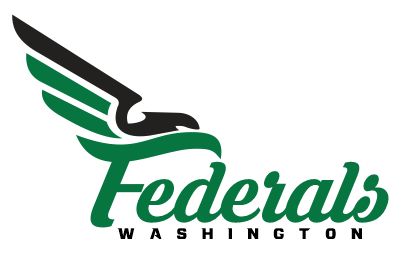
Washington Federals
Founded: 1983
Owner: Berl Bernhard
Championships: 1990, 1997
Stadium: RFK Stadium (56,692)
Colors: Kelly Green, Black, Silver
Hall of Famers: HB Craig James, LB Brandon Zavala, HC Sam Rutigliano, WR Joey Walters, DE Dexter Manley, LB Kevin Greene, WR Webster Slaughter,
1983 1989 1998 2005
A club that started out as one of the weakest in the league has evolved into a club known for shut down defense and regular playoff appearances. After short stints by former CFL coach Ray Jauch, and former Indiana HC Lee Corso, they promoted former Cleveland Browns HC Sam Rutigliano to the Head Coach position and Rutigliano helped build a winner. The Federals are arguably one of the strongest teams in the 1990's, winning titles in both 1990 and 1997. Always a threat with a stifling front 7, the Federals have also had solid QB play from first Don Majkowski and now Kordell Stewart, but usually rely on their D to keep scores low. Washington's logo is a stylized eagle in green and black. The current minimalist logo is the third variation on this theme in team history. Their uniforms feature white helmets with a wrap-around stripe, and green jerseys, with white and green pant sets.
THE 1984 EXPANSION
After only one season the USFL had become something of a sensation and ownership groups were putting in bids for potential franchises even before the first Championship was played. The league received 16 full-fledged expansion bids, but chose to limit their initial expansion to only 4 franchises. With expansion the league shifted from 3 divisions (Atlantic, Pacific and Central) by realigning teams and adding a Southern Division.
Houston Gamblers
Founded: 1984
Owner: Jerry Argovitz
Championships: 1988, 1992, 1996, 2010
Stadium: NRG Stadium (72,200)
Colors: Black, Sunset Red
Hall of Famers: FS Donald Dykes, LB Kiki DeAyala, HB Thurman Thomas, OT Howard Ballard, QB Jim Kelly, DT Michael Dean Perry, QB Doug Flutie, SS LeRoy Butler, LB Pat Swilling
Houston was awarded a franchise in the much-coveted Texas football market. The Gamblers, named after co-owner Kenny Rogers's famous song, immediately worked to select a big-name player to be the face of their franchise. When U. of Miami QB Jim Kelly was drafted by the Buffalo Bills, despite openly saying he had no desire to play there, the Gamblers lept into the negotiations and signed the highly-touted quarterback. Houston initially ran a spread-style, quick pass offense called the Run & Shoot for its first two seasons. While exciting to watch, the style led to significant hits on the somewhat slow-of-foot Kelly. For 1986 they changed OC's and adopted a more traditional 3-wideout pro-style offense. This switch paid dividends as Houston appeared in the 1987 USFL Championship, losing to the Stars, but returned in 1988 and won the league title in only their 5th season. They would prove a dynastic team with QB Jim Kelly and HB Thurman Thomas leading the charge for the next 8 years, winning titles in 1992 and 1996 and appearing in 6 Summer Bowls in that time. The Gamblers recently returned to glory, becomming the first USFL club to win a 4th title in 2010. Their logo is a G with the shape of the state of Texas forming the interior space, along with a gold star roughly placed where Houston would be.
Memphis Showboats
Founded: 1984
Owner: William Dunavant
Championships: 1999, 2007
Stadium: Liberty Bowl Stadium (56,210)
Colors: Scarlet Red, Silver Sky, Black
Hall of Famers: WR Mel Gray, WR Jo-Jo Townsell, DE Reggie White, TE Keith Jackson, SS Bennie Blades, TE Adrian Cooper, LB Pat Swilling
Playing in the football hotbed of the Mid-South, Memphis had several rough years before their team started to put the pieces together. They had a solid run of success, peaking with a Championship Game appearance in 1988. Since then they have struggled to maintain both a solid defense and a dangerous offense, often seeming to have only one of the two at any one time. The weirdest moment in their history is when Head Coach Buddy Ryan got into fisticuffs with his Offensive Coordinator on the sideline of a game, leading to his immediate firing and the promotion of that coordinator. That did not work out and within another season the team again was looking for a permanent head coach. Memphis has won 2 league titles, the first in 1999 with QB Heith Shuler, and the second in 2007 when Brett Favre came out of "retirement" to lead the 'Boats to the title. The Memphis logo is a semi-circular arch which mimics the wheel cover of a classic Mississippi River steamboat.
Jacksonville Bulls
Founded: 1984
Owner: Fred Bullard
Championships: None
Stadium: Alltell Stadium (67,383)
Colors: Burgundy, Orange, Dark Grey
Hall of Famers: LB Vaughan Johnson, DT Michael Dean Perry, SS LeRoy Butler,
The Bulls have been relatively successful since coming into the league, but have never been able to break through and win a title. Originally led by QB Doug Williams, the Bulls won two division titles in their first 3 years of USFL play. Since Williams's departure for the NFL, the team has struggled to keep the magic alive. They have built a solid rivalry with the cross-state Tampa Bay Bandits. While playoff success has been fleeting, one aspect of the Bulls identity which is undeniable has been their success at the box office. Jacksonville, despite being one of the smallest markets in the league, has been at or near the top of the USFL in attendance each season, frequently getting crowds of 45,000 or higher into their home stadium.



1984 1992 2001 2004
1984 1996 2003
1984 1990 1998 2005
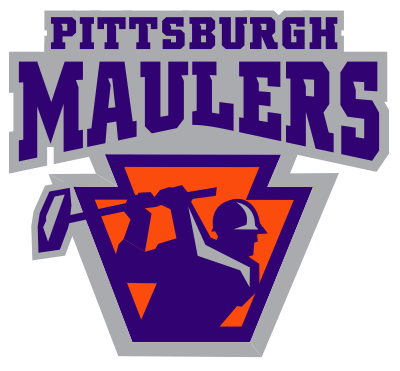
Pittsburgh Maulers
Founded: 1984
Owner: Edward DeBartolo Sr.
Championships: 1995
Stadium: Heinz Field (68,400)
Colors: Deep Purple, Orange, Steel Grey
Hall of Famers: WR John Jefferson, HB Mike Rozier, WR Raynard Brown, LB DeMetrius DuBose
1984 1992 1998 2008
Pittsburgh entered the league with high hopes, playing in a football mecca in Pittsburgh. They have done a fair job of building a following among the Steelers faithful, helped, of course, by some solid clubs and a league title in 1995. The iconic figure among Mauler faithful was HB Mike Rozier who retired after a long career as one of the most heralded players in the early years of the league. The former Heisman winner retired at or near the top of every major career rushing statistic ranking. The Maulers won their sole league title in 1995. Pittsburgh's mascot is a silhouette of a steel worker lifting aloft a mauling hammer (thus the name). The purple figure is encased in a flame orange keystone, representing the Keystone State of Pennsylvania.
THE 1987 EXPANSION
Three years after their first successful expansion, the USFL approved four more new teams, bringing the league from 16 to 20 franchises. The 1987 expansion did not require significant realignment, with only 1 franchise (Pittsburgh) changing divisions as each division shifted from 4 clubs to 5. The 1987 expansion was highlighted by significant trades and signings to bring strong starting quarterbacks to each franchise. Chicago would steal away Iowa QB Chuck Long from the NFL while San Antonio, Oklahoma and Orlando all made significant trades with USFL franchises to sign their marquee signal callers.

Chicago Machine
Founded: 1987
Owner: Bill Wirtz
Championships: None
Stadium: Soldier Field (64.588)
Colors: Deep Maroon, Metal Grey, Sky Blue
Hall of Famers: None
1987 1996 2006
When the Chicago Blitz were unable to acquire local ownership and had to seek potential relocation, the USFL was concerned that losing one of the nation's top 3 television markets would lead to a cancellation of their contract with ABC and ESPN, however, a deal was brokered that allowed the USFL 2 years to locate ownership and set up a new Chicago franchise without interruption of their lucrative television deal. The Chicago Machine are the fruits of that agreement. Over the course of 1985-1986 the league conducted an expansion search and took multiple bids for a Chicago franchise. Bill Wirtz, owner of the Chicago Blackhawks NHL club came out on top of that competition. After several lean years, the hiring of Coach Marty Schottenheimer brought greater success, including a Summer Bowl appearance in 1994. The Machine have appeared in 2 Summer Bowls since then but have yet to win a title. The Machine were named after both Chicago's industrial history as well as the "well-oiled" nickname for local politics. Chicago's logo is a multi-layered gear in the shape of a "C" which also recalls the marquee of the famous Chicago theater.

Oklahoma Outlaws - Relocated/Merged 1988
Founded: 1987, Merged with San Antonio Gunslingers to become Texas Outlaws in 1988.
Owner: William Tatham
Championships: None
Stadium: Skelly Field (40,385)
Colors: Black, Red
Hall of Famers: See Texas Outlaws
1987
In the early summer of 1985, when the league announced their 4 expansion clubs for 1987, Tulsa, Oklahoma was not one of them. The ownership group led by Fresno-based developer WIlliam Tatham was awarded a franchise for San Diego, California, a very different market from Tulsa. When Tatham and his associates failed to secure a stadium lease for San Diego's Jack Murphy Stadium, the search was on for a suitable home. There were dalliances with Seattle, Sacramento and even Honolulu before the ownership got permission to relocate the team to Tulsa. The club lasted only one year before merging with the financially shaky San Antonio Gunslingers to form the San Antonio-based Texas Outlaws. The short-lived Oklahoma Outlaw's logo was a headshot of a masked desperado complete with black hat and bandanna. The figure was outlined in white and red. The logo displayed on the stripeless black helmet of the Outlaws. The team jersey was black with wide red and white stripes. This same pattern was duplicated on the black pants of the team.

Orlando Renegades
Founded: 1987
Owner: Donald Dizney, Woody Weisner
Championships: 2001
Stadium: Citrus Bowl (52,000)
Colors: Black, Royal Blue, Silver
1987 1990 1997 2007
The Renegades are the second of the 1987 expansion clubs which was forced to relocate before even playing a game. As with Oklahoma, the Renegades also had significant setbacks in trying to get a stadium deal, which again led to relocation. Woody Weisner was awarded a franchise for Miami, but when he was unable to obtain a lease on the Orange Bowl, secondary owner Donald Dizney locked in a lease for Orlando's Citrus Bowl. The team, which was rumored to be called the Miami Spirit, was relocated and the Renegades were born. In Orlando the team has had moderate success, making playoff appearances in both 1989 and 1990 before a Summer Bowl appearance in 1991, a year in which they won 13 games. They won their first title 10 years later in 2001. Orlando's logo began as a tomahawk with two trailing feathers and the team name above it. The team later rebranded, retaining a tomahawk in their logo but going with a more minimalist and abstract depiction paired with the letter "O". The new design and uniform uses more black along with the royal and silver to form its identity.

San Antonio Gunslingers - Relocated/Merged 1988
Founded: 1987 Merged with Oklahoma to become Texas Outlaws in 1988.
Owner: Clint Manges
Championships: None
Stadium: Alamo Stadium (23,988)
Colors: Kelly Green, Royal Blue, Silver
Hall of Famers: See Texas Outlaws
1987
San Antonio represents the USFL's second foray into Texas, after the Houston Gamblers. The team played in a slightly expanded high school venue, Alamo Stadium, which made the Gunslingers the team with the lowest attendance capacity. It is believed that the Gunslingers were granted a franchise despite this shortcoming because the city had approved construction of a much larger domed stadium, the AlamoDome, home to the current Outlaws. The short-lived Gunslinger's lgoo was designed by a local newspaper cartoonist, and had been widely ridiculed around league circles. It featured a skinny Old West gunslinger about to draw his pistols. This image in black and white, is on a green circular base, with a silver outer circle containing the team name. The problem, of course, is that at any distance at all the image is indecipherable. The team's uniform included a kelly green helmet with silver, blue and white stripes, a royal blue jersey with white and green stripes, and silver pants with kelly and royal stripes. Much of the original Gunslinger design, but not the logo, was retained when San Antonio merged with Oklahoma to form the Texas Outlaws.
THE 1988 CONSOLIDATION
It did not take long for the league to realize that there were major concerns with two of the expansion franchises from their 1987 expansion. By midseason of 1987 there were regular reports that the San Antonio Gunslingers were having difficulty meeting payroll or paying vendors. After a brief investigation into the team's finances it was discovered that owner Clint Manges had exaggerated his net worth and available reserves. The team was living on a shoestring budget and required a major influx of funding. In Oklahoma the funds were there, but owner William Tatham remained adamant that Tulsa was not a long term solution for his franchise, which had originally been approved to play in San Diego. In an effort to deal with both concerns, the USFL began negotiations betweeen the two franchises to set up Tatham as the majority owner of a merged Oklahoma/San Antonio franchise. With this agreement the two teams would be combined into one Texas-based franchise, providing Tatham with the larger market he craved, and now with significant financial backing. The league then returned to the original pool of 1987 expansion clubs to find an ownership for a 20th franchise to replace the lost team from the consolidation, and selected the bid from Portland, Oregon as the most advantageous combination of ownership and market. And so, after only 1 year of play, the Oklahoma and San Antonio franchises gave way to the Texas Outlaws and Portland Thunder.

Portland Thunder -- Relocated 2004
Founded: 1988
Owner: Thunder Financial Group
Championships: None
Stadium: Civic Stadium (34,988)
Colors: Bright Lime Green, Navy, Sky Blue, Yellow
Hall of Famers: See Las Vegas Thunder
1988 1999
Portland entered the league for the 1988 season with a roster comprised primarily of former Oklahoma Outlaw players, with 10 players brought in from the San Antonio Gunslingers roster, a rookie class and a few noteable free agents. They play in Portland's Civic Stadium, which they share with the minor league baseball team, the Portland Beavers. The stadium, which began with a capacity of only 17,000, was expanded to a new capacity of almost 35,000, but remains the league's smallest. In their first few years, the Thunder struggled to win games, losing a record 15 of 16 in 1989 before a coaching change led to greater success in the 1990's, with their high point to date being a 1997 Summer Bowl appearance. Portland revived the name of the 1975 World Football League team, the Thunder, with a significantly altered color scheme and a new logo. The logo depicts Thor's famed hammer, Mjolnir, outlined in electric lime green and forming a lightning bolt with its spinning motion.

Texas Outlaws - Relocated 2017
Founded: 1988
Owner: Red Miller (1993)
Championships: None
Stadium: San Antonio AlamoDome (60,203)
Colors: Royal Blue, Kelly Green, Black
Hall of Famers: LB Brian Bosworth, HB Reggie Cobb, WR Eric Metcalf,
1988 1997 2004
The Outlaws represent the combined identity of the Oklahoma Outlaws and the San Antonio Gunslingers. When the league brokered a merger between the two franchises, Oklahoma owner William Tatham brought much of the staff, roster, and identity of his Oklahoma franchise to San Antonio. While the team's offices remain in San Antonio, the Outlaws played their first few seasons at Texas State University's Bobcat Stadium, about 40 miles from San Antonio and halfway between that city and Austin, the state capital. Once comleted, the AlamoDome, a new 60,000 seat domed stadium in San Antonio became the team's home in 1993. While much of the Outlaws initial roster was made up of former Gunslingers, Mr. Tatham arranged for several of the top stars of his Outlaws franchise, including QB Doug WIlliams and MLB Brian Bosworth to be part of the Oklahoma contingent of players who would remain with the franchise. In the team's first few years, they proved to be the most successful of the 1987 expansion teams, reaching the playoffs in their first season. They have developed a reputation over the years as choke artists, often fading down the stretch of a season or blowing a home playoff game. The team logo depicts an "outlaw" with a black hat and green kerchief, placed on a blue star.
1992 RELOCATION
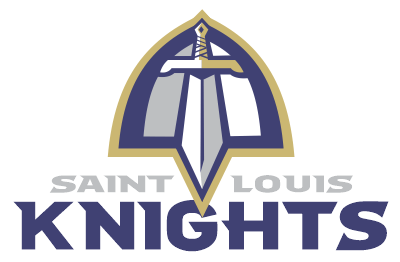
St. Louis Knights - Relocated in 2002
Founded: 1983 as Los Angeles Express
Owner: James Orthwein (1992)
Championships: None
Stadium: Busch Stadium (1992-3), Edward Jones Dome ('94-01)
Colors: Purple, Silver, Gold, Black
Hall of Famers: See Nashville Knights
1992 1999
The former LA Express had come on hard times in a tough market, and in 1991 an ownership group led by James Orthwein (of the Busch family) proposed to buy the franchise and relocate them to St. Louis. The sale was approved, along with a requirement that the Express be provided an expansion franchise by 1995. The Knights began play in Busch Stadium in 1992, and later relocated to The Dome at America's Center. However, poor leases and the arrival of the NFL Rams negatively impacted St. Louis's profitability. In 2002, after ten years in the Gateway City, the Knights would relocated to Nashville, TN. A new club would arrive in St. Louis in the 2006 league expansion.
1995 Expansion
When the sale and relocation of the LA Express to St. Louis was approved for the 1992 season, a new round of expansion was triggered. TV Deals required a franchise in the nation's second largest market by 1995. Not wanting to run a 21-team league, league executives and owners opted to expand, guaranteeing one spot to a "new Express" franchise and taking bids for additional expansion. The league did not specify whether it would expand by 2 teams or by 4. Initial bids were accepted through summer of 1992. This group was reduced to 8 finalist cities in the spring of 1993, with the final expansion teams announced during the 1993 season.

Atlanta Fire - Relocated 2003
Founded: 1995
Owner: William Shivers Morris
Championships: None
Stadium: Bobby Dodd Stadium (55,000)
Colors: Navy. Bold Orange, Flame Yellow
Hall of Famers: See Boston Cannons.
1995 2002
In 1995 Atlanta becomes the latest USFL club in the Southeast. With the considerable fiscal and football success of teams in Florida, Alabama, Tennessee, and Louisiana, it is not surprising that the league sought to add a club in the "Capital of the New South". Owned by local newspaper and media mogul William Shivers Morris, the team begins its existence by signing on to play outdoor football at Georgia Tech's Bobby Dodd Stadium instead of sharing the newly-constructed Georgia Dome with the NFL Falcons. A combination of poor teams and low crowds for summer games in hot and humid Atlanta eventually led the club to be sold and relocated to Boston. A grass roots effort to bring the Fire back succeeded with an expansion team reviving the Fire identity in 2006.
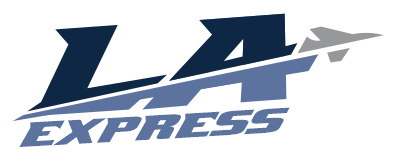
Los Angeles Express
Founded: 1995 (Reinstated via expansion)
Owner: William Tatham (1993)
Championships: None
Stadium: Farmers Insurance Field (68,838)
Colors: Navy Blue, Steel Blue, Silver
Hall of Famers: (Only for 1995 franchise, all prior Express players would be listed with the Nashville Knights). LB Mo Lewis
1995 2000 2007
When the original LA Express were approved to relocate to St. Louis (1992) it was decided that the Express name and identity would remain in place and that an expansion franchise would be approved for the 1995 season. William Tatham, principle owner of the Texas Outlaws put in a bid to sell his franchise and work with a California group to develop the new Express franchise. Upon the sale of the Outlaws, Tatham became the principle owner of the new Express. Almost immediately an agreement was made with the ownership of the NFL Raiders and the city of Carson, CA to build a new stadium for both clubs. Farmer's Insurance Field opened in 1995, becoming the home of the Express for the 1996 season. The new Express have made minor variations to the team logo and uniforms, adding the new steel blue color as highlight. The team's first big move was to bring back to LA a local hero, halfback Marcus Allen, who played for USC and the LA Raiders before being signed by Michigan of the USFL.

Ohio Glory
Founded: 1995
Owner: Daniel Galbreath & Assoc.
Championships: 2002, 2003
Stadium: Ohio Stadium (97.436)
Colors: Flag Blue, Firework Red, White
Hall of Famers: None
1995 2001 2010
Columbus, Ohio and Ohio Stadium was selected as the sight for one of four expansion clubs in 1995 in large part due to the rabid football culture of the state of Ohio. Chosen to join New Jersey, Philadelphia, Baltimore, Washington, and Pittsburgh in the Atlantic Division, rather than entering the Central division, it was hoped that Ohio would become a natural rival for the Maulers. The team is owned by a consortium led by real estate magnate Daniel Goldbreath and Domino's Pizaa mogul Thomas Monaghan. The team name and logo in part is designed to honor Ohio's long history in the United States as a birthplace of presidents, and of astronauts, like minority owner, Senator John Glenn. The team's logo is a bald eagle trailing a read and white streamer and set in a rondel designed to evoke elements of the Ohio state flag. The Glory had an incredible run in the early 2000's achieving the unthinkable, an undefeated season and a league title at 17-0. They then became the first club in the USFL to repeat as champions, winning a second title in 2003.
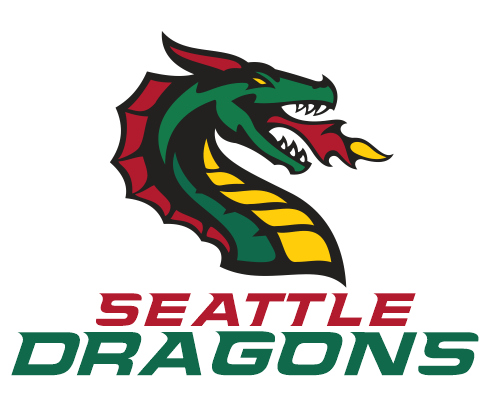
Seattle Dragons
Founded: 1995
Owner: Paul Allen, John Edson, and Barry Ackerly
Championships: 2005
Stadium: Qwest Field (68,400)
Colors: Forest Green, Fire Red, Athletic Gold
Hall of Famers: WR Eric Metcalf
1995 2003 2010
Seattle was the last of the 4 expansion clubs announced, as apparently the final decision came down to a difficult split among owners between the Allen-Edson-Ackerly bid for Seattle and a well-funded bid for Dallas, Texas. Seattle won out and the Dragons were born. The team plays not at the KingDome but up in the university district on the city's north side, utilizing the U. of Washington's open air Husky Stadium. The team name hopes to draw on two cultural groups within the city, its Scandinavian population and its East Asian population. The logo is the head and neck of a fire-breathing dragon. Seattle became one of the most unexpected league champions in 2005 when a 6-8 club managed to capture the lowest seeded Wild Card spot in the Western Conference, and then went on to win three straight road playoff games before defeating the Chicago Machine in a major Summer Bowl upset.
Relocations of the Early 2000's

Nashville Knights (2002-Relocated 2015)
Founded: Founded 1983 as LA Express, Relocated to St. Louis 1992,
relocated to Nashville in 2002.
Owner: Nashville Football Group (Cal Turner Jr., CEO)
Championships: None
Stadium: Adelphia Stadium (69,143)
Colors: Deep Purple, Metallic Gold, Metallic Silver, Black
Hall of Famers: CB Raphel Cherry, WR Jo-Jo Townsell, OG Gary Zimmerman
2003 2011
When the LA Express moved to St. Louis in 1992, it was anticipated that they would fill the football void that the departed NFL Cardinals had created when they left for Arizona. However, St. Louis started to face issues almost immediately as the new domed stadium quickly attracted a new NFL franchise, the Los Angeles Rams. For the second time in 5 years a team left LA for St. Louis, and upon their arrival, the Rams became the emphasis of the city and the stadium authority, leading to significant lease issues for the USFL Knights. In addition to these issues, lead owner James Orthwein was investigated for significant tax and insurance fraud directly tied to his purchase and later valuation of the Knights franchise. In 2001 Orthwein was forced to sell the franchise, and despite some local efforts to keep the team in St. Louis, the winning bid was from the Nashville group, an organization which hoped to bring USFL football to the Tennessee capital to share a stadium with the NFL Copperheads (a 1995 NFL expansion club). The team relocated in 2002, and received their new logo and branding in 2003.
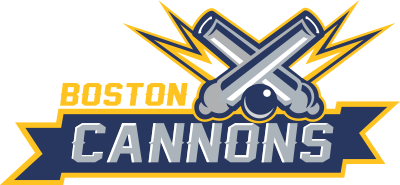
Boston Cannons (2003-Relocated 2012)
Founded: Founded in 1995 as Atlanta Fire. Relocated in 2003
Owner: Nashville Football Group (Cal Turner Jr., CEO)
Championships: 2009
Stadium: Alumni Stadium at Boston College (45,500)
Colors: Navy Blue, Gunmetal Grey, Athletic Gold
2003
After 8 years of frustration and losing in Atlanta, ownership decided to walk away from the club and sell to the highest bidder to try to maximize their investment. That bidder turned out to be a group based in Boston called the Boston Colonials Football Group. The group had an agreement in place with Alumni Stadium on the campus of Boston College to relocate the team to Boston. The league approved the sale, but was concerned about the team name leading to conflicts and legal action from the New England Patriots and the NFL. A name the team contest was held and Cannons came out on top after over 500,000 ballots were tallied. The new team began play in 2003, retaining its place in the Southern Division left over from its time in Atlanta. It soon relocated to the Northeast Division, and 6 years after relocation won a title for Boston, the city's first pro football title in the modern era.

Las Vegas Thunder (2004-- Relocated 2015)
Founded: Founded in 1987 as San Antonio Gunslingers, relocated to Portland in 1988,
Relocated to Las Vegas in 2004.
Owner: Phil Ruffin, Las Vegas Football Group
Championships: None
Stadium: Sam Boyd Stadium (30,000 + 11,000 temporary seats)
Colors: Electric Green, Navy Blue, Athletic Gold, Sky Blue
Hall of Famers: OT Bruce Armstrong, HB Robert Drummond, WR Cris Carter, WR Webster Slaughter, TE Adrian Cooper
2004
In 2001 the Portland Thunder were sold by the original ownership group. Almost immediately the new ownership group, led by Worldcom CEO Bernard Ebbers and Las Vegas casino & real estate developer Phil Ruffin, began to have issues. Ebbers was investigated for financial malfeasance within Worldcom, the fallout of which led to the USFL requiring his divestment from the Thunder. Phil Ruffin had insufficient funds to take over the controlling share of the Thunder, so a search for new ownership was initiated. Unable to locate local ownership, the league, in 2003, was forced to accept an ownership expansion proposed by Ruffin, one which would bring in several additional Las Vegas investors and bring about a hasty relocation from Portland to Sam Boyd Stadium in Las Vegas for the 2004 season. In order to reach profitability, the new owners added 11,000 temporary seats to Sam Boyd for each USFL season, increasing capacity beyond 40,000 for the facility.
2006 & 2008 Expansion

Atlanta Fire (2006)
Founded: 2006 Expansion Team
Owner: Jim Kennedy
Championships: None
Stadium: Georgia Dome (71,228)
Colors: Navy Blue, Flame Orange, Spark Yellow
Hall of Famers: None
2006
The Fire returned to the USFL after only a 3 year absence thanks to the 2006 expansion and a grassroots effort focused on returning the club rather than beginning new. The Fire were a true expansion team, but have been able to obtain the rights to the past franchise's logos, identity and club records. The Fire play in the Georgia Dome, which is hoped to alleviate one of the biggest issues that drove down attendance, namely the city's notorious summer heat and humidity. They won their first division title in 2010, their fifth season as a franchise.
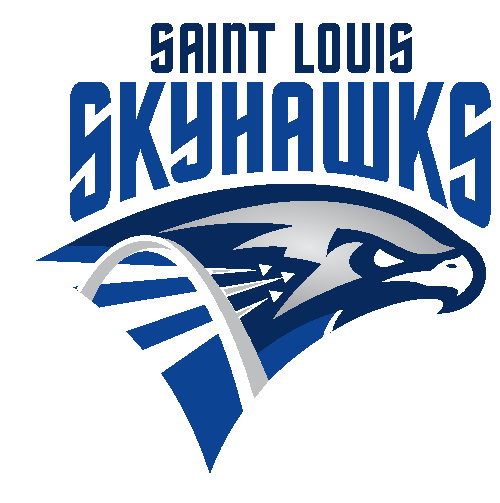
St. Louis Skyhawks (2006)
Founded: 2006 Expansion Team
Owner: David Steward/Johnny Morris
Championships: None
Stadium: The Dome at America's Center (66,965)
Colors: Navy Blue, Bright Royal Blue, Metallic Silver
Hall of Famers: None
2006
As part of the two-phase expansion, St. Louis was also guaranteed a new club after the Knights departed for Nashville. The Skyhawks are owned by two well-known local entrepreneurs, Johnny Morris, the CEO of Bass Pro Shops, and David Steward, a corporate tech mogul and the first African-American owner of a USFL franchise. The club chose Skyhawks as the moniker to celebrate both the aviation history of the city (think Spirit of St. Louis) as well as the military presence in the region. The logo was chosen by fans from three options and depicts a hawk as well as three jets flying past the iconic Gateway Arch.
Charlotte Monarchs (2008)
Founded: 2008 Expansion Team
Owner: Ben Navarro/CFFC Group
Championships: None
Stadium: Bank of America Stadium (74,867)
Colors: Charlotte Teal, Royal Purple, Light Metallic Gold
Hall of Famers: None
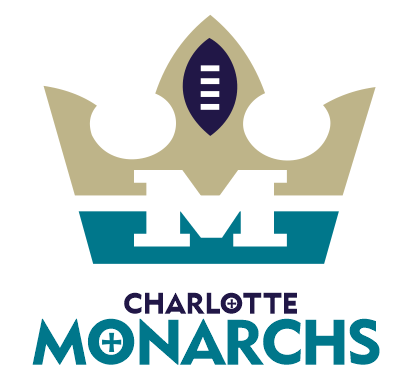
2008
The bid of Charlotte, North Carolina won out against direct competition to be the USFL's 28th team, with the Tidewater/Norfolk region of Virginia and Raleigh-Durham triangle region of North Carolina also competing to be the newest team in the Eastern Conference. The Monarchs, whose ownership group, CFFC, contains two former members of the Charlotte Hornets NBA team, opted to replicate in part the color scheme of the relocated Hornets team, using a greenish teal and a deep purple as two of their three colors, with light metallic gold as the third. The name references Charlotte as the "Queen City" of North Carolina. Its logo is based on a crown design with a football as the jewel at the center.
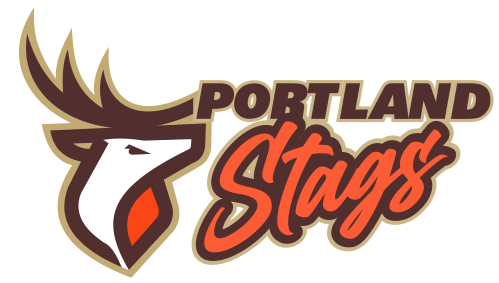
Portland Stags (2008)
Founded: 2008 Expansion Team
Owner: Timothy Boyle
Championships: None
Stadium: Columbia Sportswear Stadium (54,502)
Colors: Woodland Brown, Buff, Blaze Orange
Hall of Famers: None
2008
Portland was originally considered a darkhorse to get a USFL club back after losing the Thunder, but a local grassroots effort led to a locally-approved plan to build a new 50,000+ seat stadium, and when the expansion bid of Dallas-Fort Worth imploded, Portland became the obvious choice for a 2008 franchise. Stags beat out two other regional fauna (Pumas and Grizzlies) to become the nickname of the club owned by Columbia Sportswear CEO and President Tim Boyle. The Stags got a taste of what football would be like in their new stadium when the displaced New Orleans Breakers spent most of the 2006 season playing in the newly christened Columbia Sportswear Stadium. Two years later the city would have its own team back and the Pacific Northwest could renew a great rivalry between Portland and Seattle.
Relocations of the 2010's

Dallas Roughnecks (2012)
Founded: Founded in 1995 as the Atlanta Fire. Relocated to Boston as the Cannons in 2003, relocated to Dallas in 2012.
Owner: Dallas Football Group, CEO Mark Cuban
Championships: 2009 (Boston)
Stadium: Cotton Bowl Stadium (92,000--62,000 with tarps)
Colors: Sky Blue, Black, Red
Hall of Famers: HB Tiki Barber, HB Terrell Davis, CB Tyrone Poole, LB Randall Godfrey, LB Mo Lewis
2012
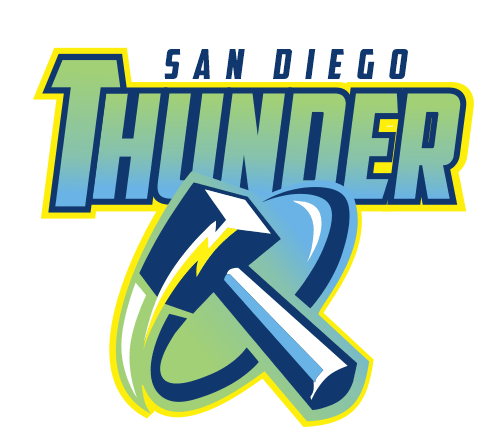
San Diego Thunder (2015)
Founded: Founded in 1987 as San Antonio Gunslingers, relocated to Portland in 1988, Relocated to Las Vegas in 2004, Relocated to San Diego in 2015
Owner: San Diego Football Group (John Moores CEO, John Tu COO)
Championships: None
Stadium: Qualcomm Stadium (70,561)
Colors: Electric Green, Navy Blue, Athletic Gold, Sky Blue
Hall of Famers: OT Bruce Armstrong, HB Robert Drummond, WR Cris Carter, WR Webster Slaughter, TE Adrian Cooper
2015
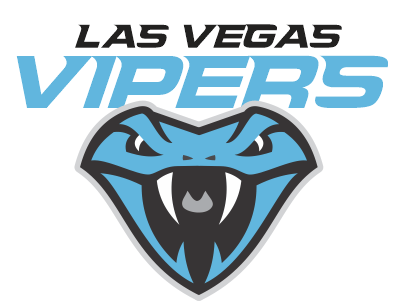
Las Vegas Vipers (2015)
Founded: Founded 1983 as LA Express, Relocated to St. Louis 1992,
relocated to Nashville in 2002, Sold & Relocated to Las Vegas 2015.
Owner: Wynn-Turner Group (Cal Turner Sr, President: Steve Wynn COO)
Championships: None
Stadium: Wynn Arena (65,000)
Colors: Deseret Blue, Silverado (Metallic Silver), Black
Hall of Famers: CB Raphel Cherry, WR Jo-Jo Townsell, OG Gary Zimmerman
2015

Oklahoma Outlaws (2017)
Founded: Founded in 1987 in Tulsa, relocated & merged with San Antonio to be the
Texas Outlaws in 1988. Returned to Oklahoma (OKC) in 2017 following the destructoin of the Alamodome in 2015 by tornadoes.
Owner: OKC Football Group
Championships: None
Stadium: OGE Energy Stadium (58,202)
Colors: Black, Crimson Red, Deep Orange
Hall of Famers: None since relocation.